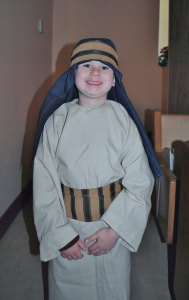In the next three weeks, I will share the process and results of directing the children’s Christmas program at my son’s school. When I first mentioned this project, posted in My Upcoming 2011-2012 Events, I was scheduling time to read and search for a script.
Often, finding the content is the most time-consuming part of the event. Preparing a solid foundation and framework provides a home for the “guts” of the event. Since the details fall into place with a set structure, I focused two-thirds of my time on preparing for the program before rehearsals began.
My planning process for this free Christmas children’s program followed this progression:
Part 1 – Script, Set, Properties
Part 2 – Cast and Crew, Costumes, and Lighting
Part 3 – Rehearsals, Program, and Performance
Script
Finding a Christmas program that meets my criteria takes a few weeks. I spent about thirty minutes each day for over a week reading print scripts and searching online. After locating this play that had great form but needed some revisions, I began the approval process through the school and contacted my father-in-law for his assistance in adapting the play. Within a week, the adapted script was in final form with approval from the school. Yeah!
After formatting the script into scenes and adding in Christmas carols, I created the cast of characters page listing all the characters for which I needed actors. (Note: Most programs come with the cast of character’s page. However, the free program I used did not have this information included.)
With the revised script and prefatory pages complete, I was ready to prepare for the performance.
Set
With the script complete, I began sketching a preliminary set for our production. Knowing the entrances and exit options for our auditorium, I took pencil and paper and drew different sized boxes for the elements needed in the script. For example, the box representing the couch was longer than the box illustrating the benches for the church pews.
I then read the script from beginning to end mapping out the blocking (traffic patterns of the actors) making sure there were no conflicts.
When the plan worked, I compiled a list of items I needed to create the set.
Properties
Also known as props, the properties are the items used by actors throughout the program. From a magazine to a mortar and pestle, I added to the set list all the properties I needed to aid the actors in communicating the gospel message.
With the prop list complete with all the items needed for this production, I was ready for the next phase.
After planning the script, set design, and properties, I was ready to execute these plans with help. The next phase of preparation for the Christmas program required a crew (helpers to carry out the plan). Next week, I will share the cast and crew, costumes, and lighting developments.
This process takes time and preparation, but with the proper foundation, all the details come together. Are there changes? Absolutely! The changes can be made easily because you know the framework and can adjust within that framework.
Whether you are directing a children’s program, hosting a birthday party, or entertaining friends, planning will take you from beginning to end. If you don’t have a framework, then you will continue to make adjustments, and your participants will get confused. For any successful event, the key is using time wisely to organize. Happy planning!
